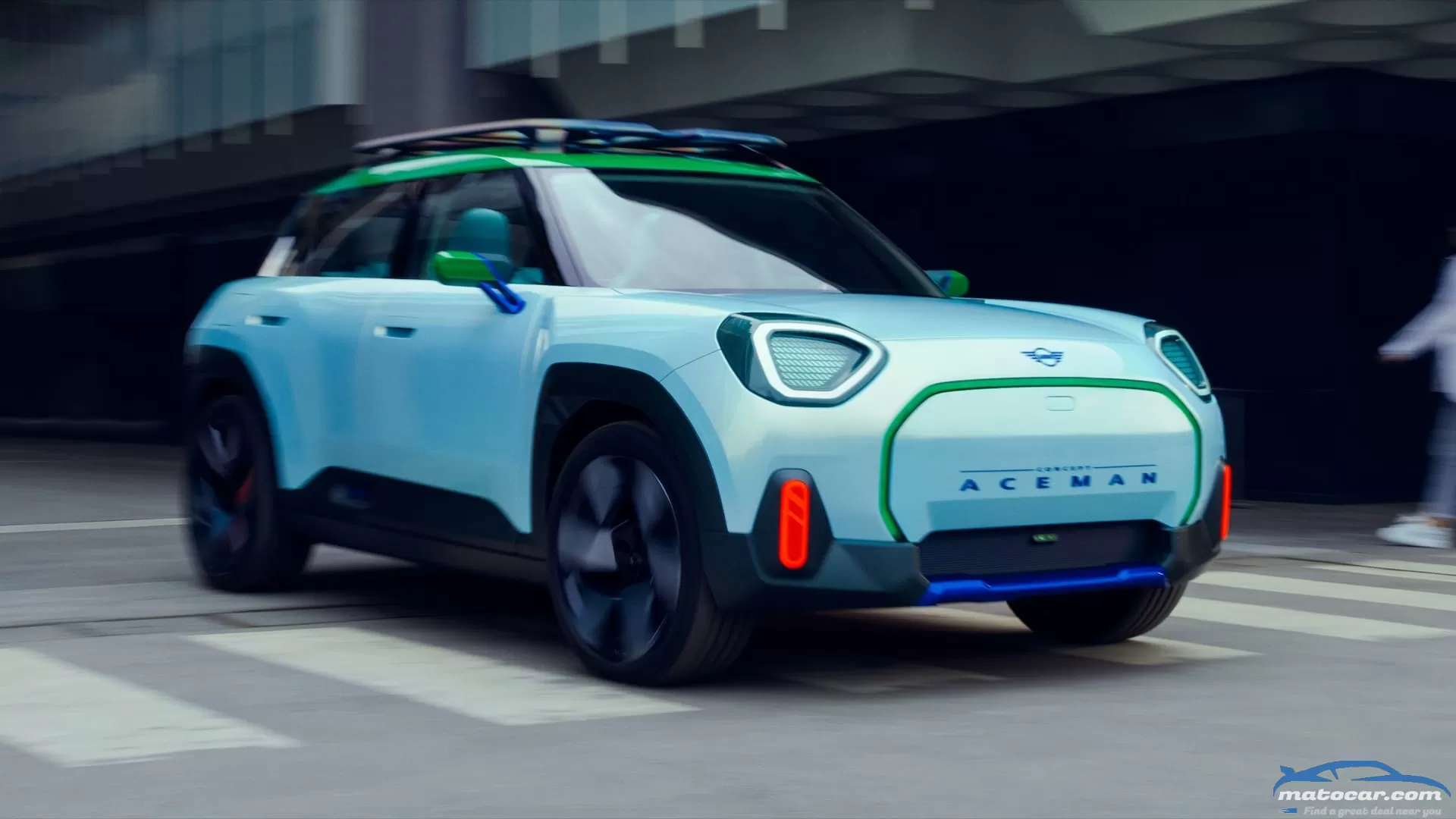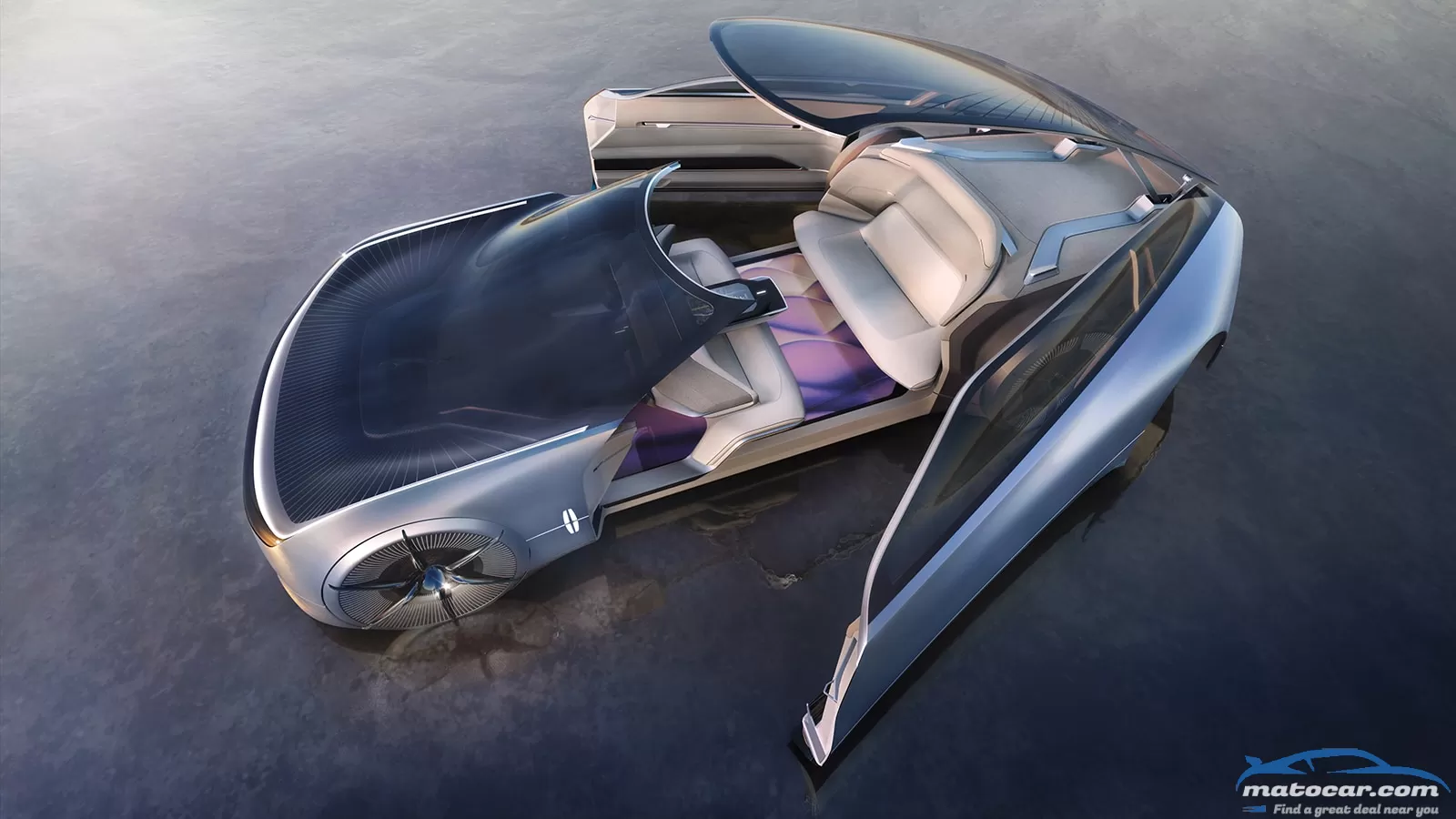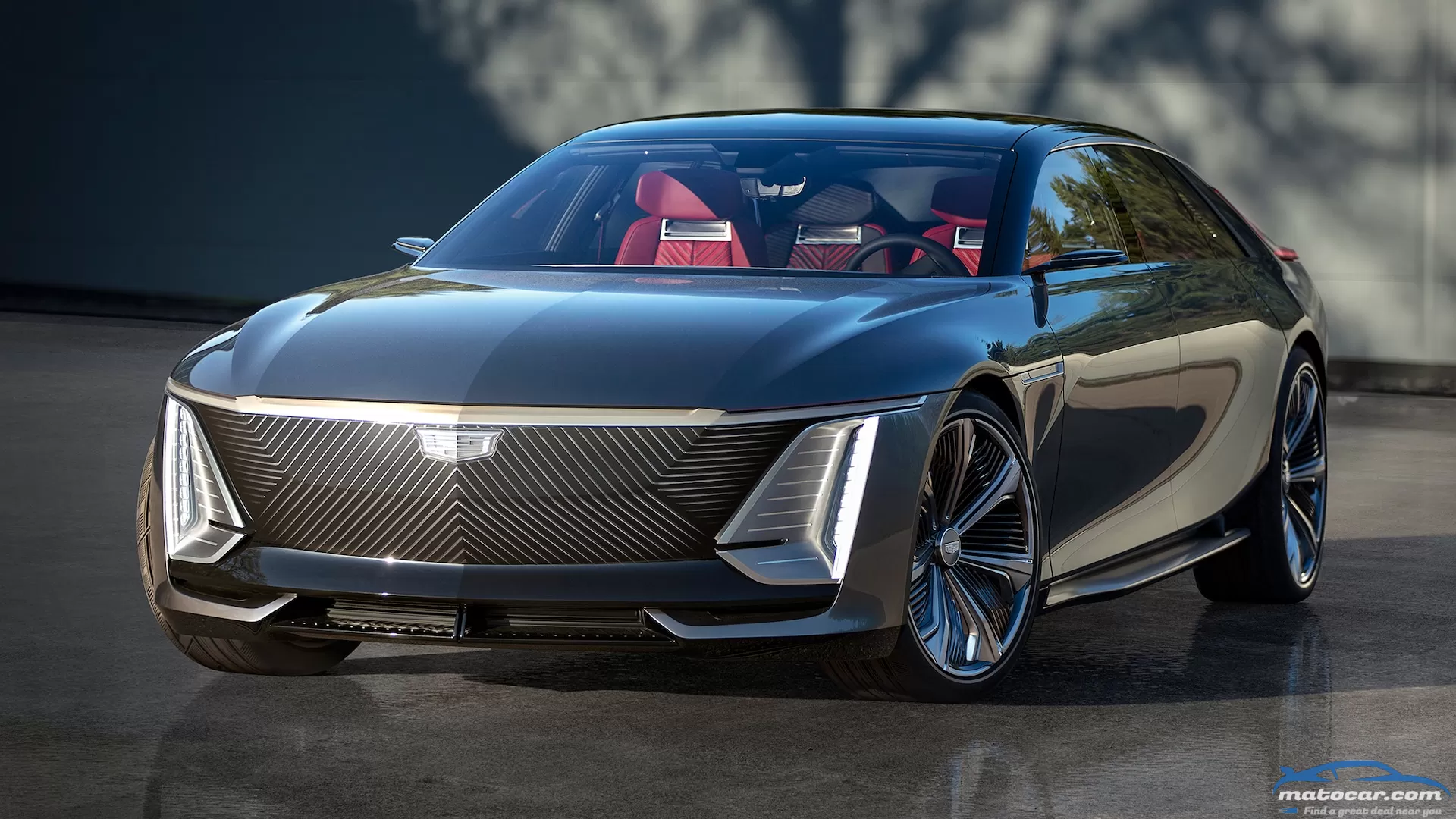Mini Concept Aceman: Angular, Unusual Glimpse at the Brand's EV Future

Mini may have only one EV in its current lineup, but it is well on its way to meeting the BMW Group's directive of having at least half of its vehicles go electric by 2030. Mini is starting to tease that electric future one concept model at a time. It wasn't long ago that the brand bought a "skunkworks" Mini Cooper SE convertible to Miami, Florida as a feeler.
Now Mini is pulling back more of its electric curtain with the debut of its Concept Aceman. The Mini Concept Aceman would be the brand's first EV crossover and "provides a glimpse of a completely new vehicle, bridging the space between the Mini Cooper and the Mini Countryman in the future of the model family," says Stefanie Wurst, Head of Mini in a release.
The Mini Concept Aceman is supposed to "reflect how Mini is reinventing itself for its all-electric future and what the brand stands for: an electrified go-kart feel, an immersive digital experience and a strong focus on a minimal environmental footprint," according to Wurst.
Mini's new design language
Unlike the Mini Cooper SE convertible (or the Cooper SE hatch on which that model is based), the Mini Concept Aceman is more than a drivetrain swap into a current Mini chassis. The Aceman also serves as a preview for Mini's new design language. Obviously, Mini wouldn't completely abandon the major design elements that are synonymous with the brand but it is looking to make changes that better align with its so-called "reinvention."
"With this approach, we are redeveloping the Mini design icons, with all their analogue strengths, for the digital future," said Adrian van Hooydonk, Head of BMW Group Design.
According to the official press release, Mini officially refers to its new design language as "Charismatic Simplicity." One of the most noticeable elements is the octagonal front "grille" which is really more of an illuminated outline that borders the radiator area. The geometric theme continues to the headlights. It's different for Mini, but there aren't so many angles and creases that the overall design isn't relatable to the classic rounded headlights that Mini is known for.
The interior is a study in tech minimalism
Passengers face a dashboard that is nearly devoid of tactile buttons, vents, or gauges. There is a round OLED touchscreen in the center of the dash, which serves as the hub of all of the infotainment as well as readouts like speed and battery range. Underneath the OLED screen is where traditional Mini toggle switches can be found.
The infotainment system utilizes the Mini Companion software which offers "sensor based animation" that choreographs light and sound for what Mini calls a "holistic user experience." These animations extend into light arrays that are hidden in the dashboard and door panels. Different animations will playout through the OLED screen, dashboard, and door panels as passengers enter and exit the vehicle.
Moving image projections can also transfer graphics and animations from the Mini Operating System to the dashboard for an added wow factor. These animations can create "diversified interactions" on the OLED screen when stopped at a light or charging the battery.
The Mini Concept Aceman is set to make its debut physical appearance at the Gamescom video game fair in Cologne, Germany on August 23, 2022.
You may also like
Plenty Of PowerPictured: Mazda CX-50More To Come
Brace yourself. The Lincoln concept debuting at the Pebble Beach Concours d'Elegance is a massive take on a future luxury electric car with a giant 14-foot reverse-hinged door—longer than some entire vehicles—and even features its own red carpet for a dramatic, royal arrival wherever it goes. Ford's luxury brand makes a grand statement with the Lincoln Model L100 Concept. The name is in celebration of Lincoln's 100th anniversary and pays homage to the automaker's first luxury vehicle, the 1922 Model L.While the name is a nod to the past, the car is very much the future of Lincoln. The brand has promised a full electric vehicle lineup, with three new EVs by 2025, a fourth in 2026, and a fully electrified portfolio by 2030. For a glimpse into what the near-term EVs will look like, Ford's luxury brand first showed us the Lincoln Star concept, an electric streamlined SUV with dynamic lighting, transparent frunk, and coach doors. The Lincoln Model L100 is the long-range preview of a world where autonomous vehicles share the road with EVs driven manually.Designing the Lincoln L100 From the Inside OutDesigners and modelers worked furiously to pull a show car together to toast the past and future simultaneously with a debut during the country's most ostentatious car event: Monterey Car Week. The five-passenger concept was designed digitally first and a foam model of the massive car grew from that. A version in sheetmetal, with the help of 3D printing, was being pulled together right up to the reveal deadline.The final show car is imposing. It is longer than a Lincoln Navigator L; the long-wheelbase SUV is 18.5 feet long. The L100 dwarfs it at more than 20 feet long and 6 ½ feet wide with more than 16 feet of interior space. Lincoln Global Design Director Kemal Curic said they built the interior first and it is the largest that Lincoln has ever created. Then came the exterior, resplendent in metallic paint paired with frosted acrylic in lieu of chrome to create a soft white that transitions to blue.In a nod to the past: the concept was designed so it can still be driven. In a nod to the future: the driver can decide to lean back, stretch out, and let the car drive completely autonomously, in theory.Step Inside and Stretch OutThe 14-foot door is a piece of art with the most complex rear hinge the automaker, or maybe any automaker, has ever attempted. Once open you can remain upright as you enter the cabin—no yoga moves required to reach the queen and king seats in the back, which can be set to lounge mode with legs out and heads resting against the huge singular headrest that spans the cavernous interior. In autonomous mode, the dash disappears under the instrument panel and occupants have an unobstructed view of what is ahead.The seating layout is designed to be social. Passengers can all face forward, or front passengers can swivel to face their rear companions. The digital floor can create a mood or experience, such as projecting the image of flying above the clouds in an attempt to take passengers back to the time of romance and travel.The car plays up all the senses in a minimalist interior. Screens are not overpowering, there is no steering wheel or column. The animal-free materials in the cabin include a recycled suede-like fabric with amethyst accents.Tap Into Your Inner Child and Steer Like A Toy CarTo steer, there is a center console chessboard with a crystal chess piece controller that replaces a traditional steering wheel. Think of how a child plays with a toy car, grabbing its sides and sliding it forward or twisting it to turn. The same motions with the chess piece direct the car. An adult from any seat can assume control—there is no set driver or passenger seat since there is no restrictive steering column to work around.The lighting projects a red carpet onto the ground, but the concept also goes beyond puddle lighting. Tracking lighting detects you and follows you, 360 degrees, as you walk around the vehicle—an artificial intelligence feature designed to make you feel both safe and special, as if it knows you.The frunk was designed to be a jewelry box and there is a heritage jewel inside: a crystal greyhound ornament under the transparent hood that harkens back to the hood ornament originally selected by Edsel Ford in the 1920s to symbolize the grace and elegance of the Lincoln brand, which the Ford Motor Company had purchased.The L100 has a modern take on the Lincoln star logo on the front of the car. It is simple and backlit, like the apple on a MacBook. This is the first use of this new adaptation and could become a signature on future models.It is only a concept, so powertrain can be fictional. Lincoln officials say the L100 would use a solid-state battery to provide greater range at less cost. The teardrop shape and long tail give it the aerodynamics needed for greater efficiency, along with closed-off wheels and air flow through the bottom of the grille.At first glance the car appears to have an extremely long hood, but it actually starts almost in front of the front wheel with a cut line rear of the hood. The rear is sliced off, with a sharp angle like the back of a super yacht. The glass roof seamlessly melds into the body at the rear.LED Lights are the New ChromeLike most EVs, the concept plays up lighting as a new brand signature. LEDs are the new chrome, Curic says. The spinning wheels have smart covers that use sensors and lighting. The digital look makes it look like the car is gliding along the road. The glowing wheels also indicate the car's rate of charge, like giant analog dials.The L100 sets the pace for the future, says Lincoln Global Product Director John Jraiche. "A lot of the form language and strategy will be in future Lincolns." He says Lincoln is not beholden to its past and is creating a new identify in the EV age. Some aspects are pure concept -the massive door won't make it to production—but the idea behind it, of the car welcoming and hugging its occupants, is an idea that will be taken forward to production models. Some of the lighting and the face of the L100 could be in the first Lincoln EVs to hit the market, Curic says.The L100 project started before the Lincoln Star concept and the two proceeded in parallel, as two takes on the future of Lincoln from different time points, with brand signifiers in both vehicles. The team does not rule out a smaller version of the L100 for production. "Lincoln has always been special to me and my family, especially my father and my grandfather. If there is one secret to Lincoln's longevity, it is the brand's ability to balance its core values with a desire to innovate and create the future," said Ford executive chair Bill Ford in a statement. "Lincoln has been one of the most enduring and stylish automotive brands in the world and in many ways, it is perfectly positioned for a second century defined by great design, zero-emissions and technology-led experiences."
Cadillac's New FaceHand AssemblyAluminum Spaceframe With Applied Panels Four First-Class Eames ChairsTheatrical Red With Ombre ShadingCoffee-Tanned Leather, Pillar-to-Pillar Screen.Return of the GoddessHow Much of This Will Make Production?When, How, and How Much?2024 Cadillac Celestiq Specifications BASE PRICE $300,000 (est) LAYOUT Front- and rear-motor, AWD, 4-pass, 4-door hatchback MOTORS 2 x 315-hp/400-lb-ft (est) AC, permanent-magnet electric TRANSMISSIONS 1-speed auto CURB WEIGHT 6,000 lb (est) WHEELBASE 120.0 in (est) L x W x H 210.5 x 79.7 x 57.5 in (est) 0-60 MPH 4.5 sec (MT est) EPA FUEL ECON Not yet rated EPA RANGE, COMB 300 miles (est) ON SALE Early 2024 Show All

-to-its-rear-wheels.webp)


0 Comments